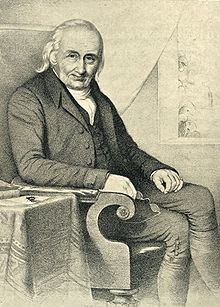- William Kirby (entomologiste)
-
William Kirby, né le 19 septembre 1759 à Witnesham dans le Suffolk et mort le 4 juillet 1850 à Barham également dans le Suffolk, est un entomologiste anglais.
Kirby poursuit des études à Ipswich puis au Caius College de Cambridge. Il entre dans les ordres en 1782 et passe toute sa vie dans la tranquille bourgade de Barham (Suffolk).
Il était passionné d'histoire naturelle et particulièrement d'entomologie. En 1802, il se fait connaître des spécialistes anglais et internationaux de son époque en publiant une Monographia Apum Angliae (en 2 volume), le premier traité sur ces espèces d'Hyménoptères Aculéates.
À partir de 1805, Kirby, avec son ami William Spence, entreprend d'écrire un important traité d'entomologie. Le premier volume d'Introduction to Entomology commence à paraître en 1815 et le quatrième en 1826. C'est une présentation détaillée de l'entomologie mais Kirby, dans le dernier volume, introduit une histoire de l'entomologie ainsi qu'un système de classification inspiré par les travaux de William Sharp MacLeay.
De 1819 à 1821, il fait paraître son Horae Entomologicae or Essays on the Annulose Animals, où il propose une classification complète du monde animal très originale et très artificielle. Ainsi, les Arthropodes sont rangés en grandes catégories, elles-mêmes classées en cinq sous-groupes. Sans doute pour suggérer que le monde naturel porte la marque des doigts de Dieu.
Dans la préface de son quatrième volume de A Hand-book to the Order Lepidoptera (1897), il évoque déjà un code de conduite pour les entomologistes :
« Finally, attention has recently been called to the reckless manner in which some collectors virtually exterminate local insects : and the Entomological Society of London has appointed a committee to consider the subject. It is the duty of every right-feeling Entomologist (even if only an amateur, and whether collecting at home or abroad) not to kill a single specimen more than he actually requires for scientific purposes. Nor is there any reason to objects to an Entomologist being only an amateur, or, as it is sometimes termed, "a mere collector," for the range of Entomology is vast, and there is plenty of room for workers in all directions. A Lepidopterist may not admire a fly or a beetle, but he need not look down on those who do ; and a systematist need not underrate the work of a physiologist, or vice versa [en français dans le texte]. Specialism there must be in all branches of science, but there need not narrowness or exclusiveness in our work ; and at the risk of being thought a preacher, I am anxious to impress more enlarged views on the minds of those of the younger generation of Entomologists who are willing to read this Preface to the end.
W.F. Kirby, Chiswick, janvier 1897. »À côté de ses livres d'histoire naturelle et de ses nombreuses publications dans les Transactions of the Linnean Society, le Zoological Journal et bien d'autres revues, Kirby a une abondate production, notamment théologique :
- Strictures on Sir James Smith's Hypothesis respecting the Lilies of the Field of our Saviour and the Acanthus of Virgil (1819)
- Seven Sermons on our Lords Temptations (1829), etc.
- Portail de l’histoire de la zoologie et de la botanique
- Portail de l’entomologie
- Portail de la zoologie
Catégories :- Entomologiste
- Entomologiste britannique
- Naissance en 1759
- Décès en 1850
- Membre de la Royal Society
Wikimedia Foundation. 2010.

